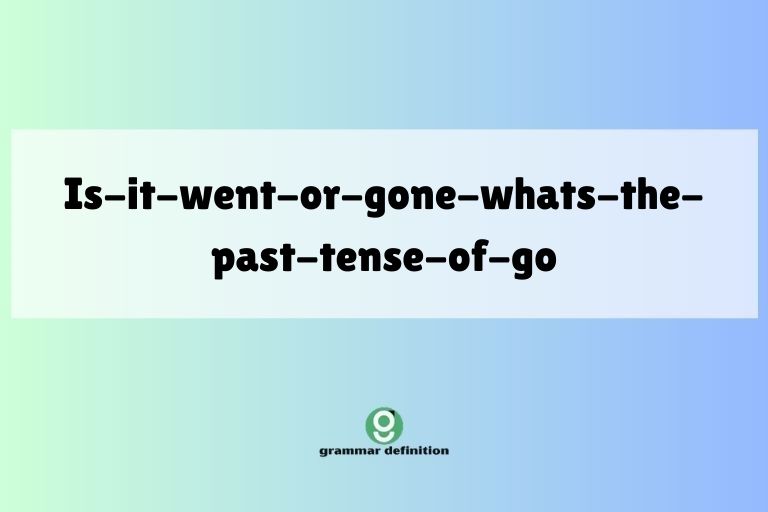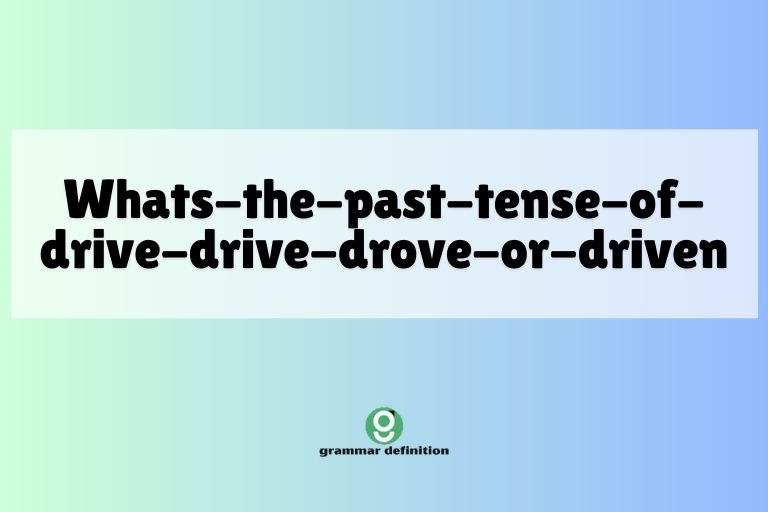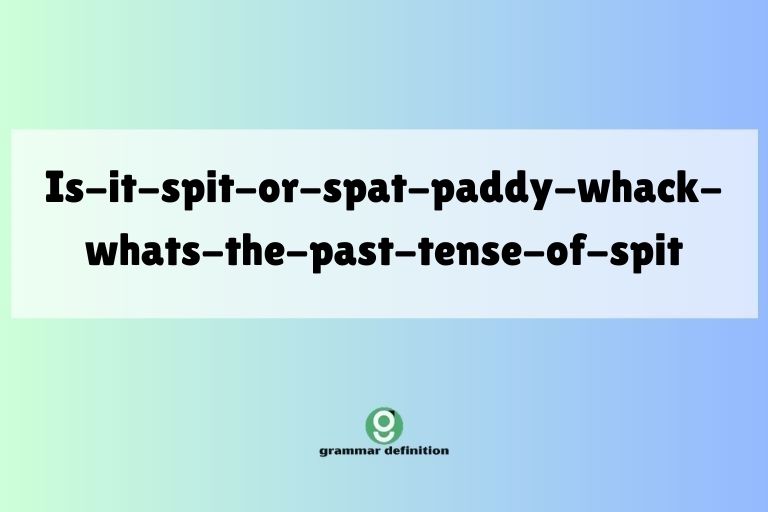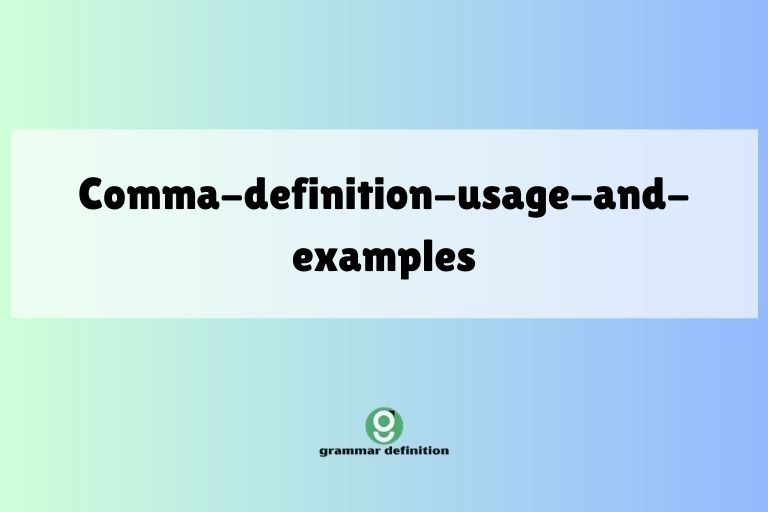Mastering Subject-Verb Agreement: 9 Essential Rules
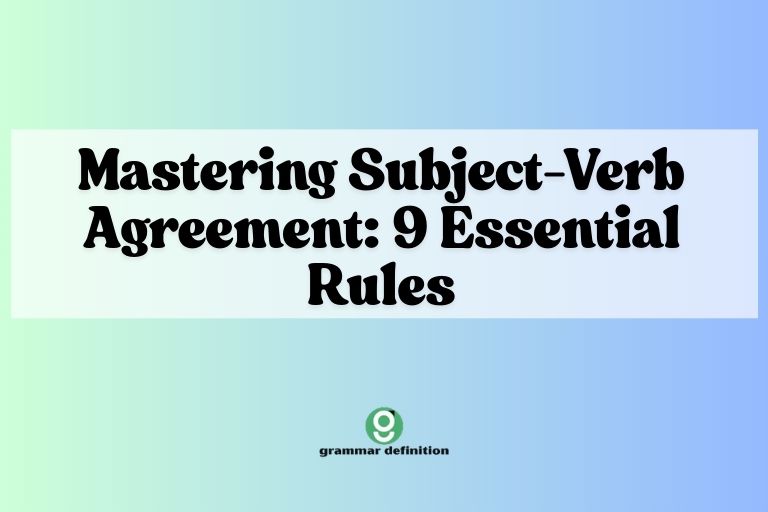
Subject-verb agreement is a fundamental aspect of English grammar, ensuring that the verb in a sentence agrees in number (singular or plural) with its subject. Mastering this concept is crucial for clear and effective communication, both in writing and speaking.
A solid grasp of subject-verb agreement enhances the credibility of your communication and prevents misunderstandings. This article provides a comprehensive guide to subject-verb agreement, covering essential rules, common mistakes, and practice exercises.
This article is beneficial for English language learners, students, writers, and anyone seeking to improve their grammatical accuracy and clarity. By understanding and applying these rules, you can significantly enhance the precision and professionalism of your English.
Table of Contents
- Definition of Subject-Verb Agreement
- Structural Breakdown
- Types and Categories
- Examples of Subject-Verb Agreement
- 9 Essential Rules of Subject-Verb Agreement
- Common Mistakes in Subject-Verb Agreement
- Practice Exercises
- Advanced Topics in Subject-Verb Agreement
- Frequently Asked Questions
- Conclusion
Definition of Subject-Verb Agreement
Subject-verb agreement, also known as concord, is a grammatical principle that dictates that the verb in a sentence must match the number and person of its subject. In simpler terms, a singular subject requires a singular verb, and a plural subject requires a plural verb.
This agreement ensures clarity and grammatical correctness in sentences. The subject and verb must agree regardless of the sentence’s complexity or the presence of intervening phrases.
This foundational rule is essential for constructing grammatically sound and easily understandable sentences.
Subject-verb agreement is not only a matter of grammatical correctness but also plays a vital role in conveying the intended meaning accurately. Incorrect subject-verb agreement can lead to confusion and misinterpretation.
For example, consider the difference between “The dog barks” and “The dogs bark.” The former indicates a single dog, while the latter indicates multiple dogs. Understanding subject-verb agreement is crucial for both native speakers and learners of English.
Structural Breakdown
The basic structure of a sentence involving subject-verb agreement is straightforward: Subject + Verb (+ Object/Complement). The subject is the noun or pronoun that performs the action, and the verb is the action word. The verb must agree with the subject in number (singular or plural) and person (first, second, or third). This agreement is most apparent in the present tense.
For example, in the sentence “She sings,” “She” is the singular subject, and “sings” is the singular verb. Conversely, in the sentence “They sing,” “They” is the plural subject, and “sing” is the plural verb.
The object or complement is the part of the sentence that receives the action or provides additional information about the subject. These elements do not affect the subject-verb agreement but are crucial for a complete sentence structure.
Understanding this basic structure provides a solid foundation for mastering more complex rules of subject-verb agreement.
Types and Categories
Subject-verb agreement can be categorized based on several factors, including the type of subject (singular, plural, collective), the presence of compound subjects, and the use of indefinite pronouns. Each category presents unique challenges and requires specific rules to ensure correct agreement.
Understanding these categories is essential for mastering the nuances of subject-verb agreement.
Singular and Plural Subjects
The most basic distinction is between singular and plural subjects. A singular subject refers to one person, place, thing, or idea, while a plural subject refers to two or more.
Singular subjects take singular verbs, and plural subjects take plural verbs. This is the foundation of subject-verb agreement.
Compound Subjects
Compound subjects are two or more subjects joined by a conjunction such as “and,” “or,” or “nor.” The verb agreement depends on the conjunction used. When subjects are joined by “and,” the verb is usually plural.
When subjects are joined by “or” or “nor,” the verb agrees with the subject closest to it.
Collective Nouns
Collective nouns refer to a group of people or things as a single unit (e.g., team, family, committee). Collective nouns can be either singular or plural, depending on whether the group is acting as a single unit or as individual members.
If the group is acting as a single unit, the verb is singular. If the members of the group are acting individually, the verb is plural.
Indefinite Pronouns
Indefinite pronouns refer to nonspecific people or things (e.g., everyone, someone, nobody, all, some). Some indefinite pronouns are always singular (e.g., everyone, someone, nobody, each, every), while others can be singular or plural depending on the context (e.g., all, some, none, any, more, most).
Examples of Subject-Verb Agreement
To illustrate the principles of subject-verb agreement, consider the following examples. These examples are categorized to show how the rules apply in different contexts, including singular subjects, plural subjects, compound subjects, collective nouns, and indefinite pronouns.
Each category is presented in a table format for clarity and ease of understanding.
Singular and Plural Subjects Examples
This table presents examples of subject-verb agreement with singular and plural subjects. It highlights the basic principle of matching the verb form to the subject’s number.
| Subject | Verb | Example Sentence |
|---|---|---|
| The dog | barks | The dog barks loudly. |
| The dogs | bark | The dogs bark at the mailman. |
| She | sings | She sings beautifully. |
| They | sing | They sing in the choir. |
| He | runs | He runs every morning. |
| We | run | We run in the park. |
| It | rains | It rains frequently in April. |
| Clouds | gather | Dark clouds gather before a storm. |
| The car | needs | The car needs to be washed. |
| The cars | need | The cars need new tires. |
| My mother | cooks | My mother cooks delicious meals. |
| My parents | cook | My parents cook together on weekends. |
| The book | is | The book is very interesting. |
| The books | are | The books are on the table. |
| The teacher | explains | The teacher explains the lesson clearly. |
| The teachers | explain | The teachers explain the concepts well. |
| The student | studies | The student studies hard for the exam. |
| The students | study | The students study together in the library. |
| The flower | blooms | The flower blooms in the spring. |
| The flowers | bloom | The flowers bloom in the garden. |
| The bird | flies | The bird flies south for the winter. |
| The birds | fly | The birds fly in formation. |
| The house | stands | The house stands on the hill. |
| The houses | stand | The houses stand in a row. |
| The city | grows | The city grows rapidly. |
| The cities | grow | The cities grow in population. |
| My friend | plays | My friend plays the guitar. |
| My friends | play | My friends play soccer in the park. |
Compound Subjects Examples
This table illustrates subject-verb agreement with compound subjects joined by “and,” “or,” and “nor.” It demonstrates how the verb form changes based on the conjunction used.
| Subject | Verb | Example Sentence |
|---|---|---|
| John and Mary | are | John and Mary are going to the party. |
| The cat and the dog | play | The cat and the dog play together. |
| Coffee and toast | is | Coffee and toast is my usual breakfast. (treated as a single unit) |
| Either the cat or the dog | is | Either the cat or the dog is going to the vet. |
| Either the cats or the dog | is | Either the cats or the dog is going to the vet. |
| Either the cat or the dogs | are | Either the cat or the dogs are going to the vet. |
| Neither John nor Mary | is | Neither John nor Mary is coming to the meeting. |
| Neither the students nor the teacher | is | Neither the students nor the teacher is present. |
| Neither the teacher nor the students | are | Neither the teacher nor the students are present. |
| My brother and I | are | My brother and I are planning a trip. |
| The book and the pen | are | The book and the pen are on the desk. |
| The singer and the dancer | perform | The singer and the dancer perform together. |
| The car and the truck | need | The car and the truck need repairs. |
| The house and the garden | look | The house and the garden look beautiful. |
| The sun and the moon | shine | The sun and the moon shine in the sky. |
| The rain and the wind | are | The rain and the wind are causing a storm. |
| The bread and butter | is | The bread and butter is a simple meal. (treated as a single unit) |
| Either the teacher or I | am | Either the teacher or I am going to lead the session. |
| Either he or she | is | Either he or she is responsible for the error. |
| Neither the players nor the coach | agrees | Neither the players nor the coach agrees with the decision. |
| Neither the coach nor the players | agree | Neither the coach nor the players agree with the decision. |
| The director and producer | is | The director and producer is arriving soon. (same person) |
| The director and the producer | are | The director and the producer are arriving soon. (different people) |
| Love and affection | is | Love and affection is what every child needs. |
| Patience and understanding | are | Patience and understanding are important qualities. |
| The hammer and the nails | are | The hammer and the nails are in the toolbox. |
| The fork and the knife | are | The fork and the knife are on the table. |
Collective Nouns Examples
This table provides examples of subject-verb agreement with collective nouns. It illustrates how the verb form depends on whether the collective noun is acting as a single unit or as individual members.
| Subject | Verb | Example Sentence |
|---|---|---|
| The team | is | The team is playing well. (as a unit) |
| The team | are | The team are arguing about the strategy. (as individuals) |
| The family | is | The family is going on vacation. (as a unit) |
| The family | are | The family are deciding what to do. (as individuals) |
| The committee | meets | The committee meets every Tuesday. (as a unit) |
| The committee | disagree | The committee disagree on the budget. (as individuals) |
| The audience | was | The audience was captivated by the performance. (as a unit) |
| The audience | were | The audience were clapping and cheering. (as individuals) |
| The jury | has | The jury has reached a verdict. (as a unit) |
| The jury | are | The jury are divided in their opinions. (as individuals) |
| The class | is | The class is studying diligently. (as a unit) |
| The class | are | The class are working on different projects. (as individuals) |
| The government | is | The government is implementing new policies. (as a unit) |
| The government | have | The government have different opinions on the matter. (as individuals) |
| The band | plays | The band plays at the concert. (as a unit) |
| The band | are | The band are tuning their instruments. (as individuals) |
| The crowd | is | The crowd is cheering for the team. (as a unit) |
| The crowd | are | The crowd are dispersing after the game. (as individuals) |
| The staff | is | The staff is dedicated to their work. (as a unit) |
| The staff | are | The staff are taking their breaks. (as individuals) |
| The flock | flies | The flock flies south for the winter. (as a unit) |
| The flock | scatter | The flock scatter when disturbed. (as individuals) |
| The herd | grazes | The herd grazes in the meadow. (as a unit) |
| The herd | move | The herd move to find better pasture. (as individuals) |
Indefinite Pronouns Examples
This table illustrates subject-verb agreement with indefinite pronouns. It shows how the verb form depends on whether the indefinite pronoun is singular or plural, and how context can influence the agreement.
| Subject | Verb | Example Sentence |
|---|---|---|
| Everyone | is | Everyone is invited to the party. |
| Someone | has | Someone has left their umbrella. |
| Nobody | knows | Nobody knows the answer. |
| Each | has | Each has a role to play. |
| Every | is | Every student is responsible for their work. |
| All | are | All of the students are present. |
| All | is | All of the milk is gone. |
| Some | are | Some of the books are missing. |
| Some | is | Some of the water is polluted. |
| None | are | None of the cookies are left. |
| None | is | None of the information is correct. |
| Any | is | Any of the pie is fine with me. |
| Any | are | Are any of the tickets still available? |
| More | is | More of the work is needed. |
| More | are | More of the workers are needed. |
| Most | is | Most of the money is spent. |
| Most | are | Most of the people are happy. |
| Everything | is | Everything is ready for the event. |
| Something | is | Something is wrong with the engine. |
| Anything | is | Anything is possible if you believe. |
| Nothing | is | Nothing is impossible. |
| One | is | One of the students is absent. |
| Several | are | Several are coming to the party. |
| Few | know | Few know the secret. |
| Many | are | Many are interested in the topic. |
| Both | are | Both are excellent choices. |
9 Essential Rules of Subject-Verb Agreement
The following rules provide a comprehensive guide to ensuring correct subject-verb agreement in various contexts. These rules cover both basic and more complex situations, including exceptions and special cases.
Mastering these rules is essential for writing grammatically correct and clear sentences.
- Rule 1: Singular subjects take singular verbs, and plural subjects take plural verbs. This is the most fundamental rule of subject-verb agreement. For example: The cat sleeps. (singular) vs. The cats sleep. (plural).
- Rule 2: When two or more subjects are joined by “and,” use a plural verb. For example: John and Mary are going to the party. However, if the subjects refer to the same person or thing, use a singular verb: The director and producer is arriving soon.
- Rule 3: When two or more singular subjects are connected by “or” or “nor,” use a singular verb. For example: Either the cat or the dog is going to the vet.
- Rule 4: When a singular and a plural subject are connected by “or” or “nor,” the verb agrees with the subject closest to it. For example: Neither the students nor the teacher is present. vs. Neither the teacher nor the students are present.
- Rule 5: Collective nouns take a singular verb when the group is acting as a single unit and a plural verb when the members of the group are acting individually. For example: The team is playing well. (as a unit) vs. The team are arguing about the strategy. (as individuals).
- Rule 6: Indefinite pronouns such as “everyone,” “someone,” “nobody,” “each,” and “every” are always singular and take singular verbs. For example: Everyone is invited to the party.
- Rule 7: Indefinite pronouns such as “all,” “some,” “none,” “any,” “more,” and “most” can be singular or plural, depending on the noun they refer to. If the noun is countable, use a plural verb; if the noun is uncountable, use a singular verb. For example: All of the students are present. (countable) vs. All of the milk is gone. (uncountable).
- Rule 8: Phrases that come between the subject and verb do not affect subject-verb agreement. For example: The book, including all the chapters, is interesting. The subject is “book,” not “chapters.”
- Rule 9: In sentences that begin with “there is” or “there are,” the subject follows the verb. The verb agrees with the subject that follows it. For example: There is a book on the table. vs. There are books on the table.
Common Mistakes in Subject-Verb Agreement
Subject-verb agreement is a common source of errors, even for native English speakers. These mistakes often arise from overlooking the subject, misidentifying collective nouns, or misinterpreting compound subjects.
Recognizing these common errors is the first step in avoiding them.
One frequent mistake is failing to account for phrases that come between the subject and verb. For example, the sentence “The box of chocolates are delicious” is incorrect because the subject is “box,” which is singular, so the verb should be “is.” Another common error involves collective nouns.
Many people mistakenly treat collective nouns as always plural, leading to errors like “The team are playing well” when the team is acting as a unit. Compound subjects can also be confusing, especially when “or” or “nor” is used.
It’s essential to remember that the verb agrees with the subject closest to it in these cases.
Here’s a table illustrating some common mistakes and their corrections:
| Incorrect | Correct | Explanation |
|---|---|---|
| The box of chocolates are delicious. | The box of chocolates is delicious. | The subject is “box,” which is singular. |
| The team are playing well. | The team is playing well. | “Team” is acting as a single unit. |
| Neither the students nor the teacher are present. | Neither the students nor the teacher is present. | The verb agrees with “teacher,” which is singular. |
| Everyone are invited to the party. | Everyone is invited to the party. | “Everyone” is always singular. |
| There is many books on the table. | There are many books on the table. | The subject is “books,” which is plural. |
| The data is incorrect. | The data are incorrect. | “Data” is the plural of “datum”. |
| Economics are a difficult subject. | Economics is a difficult subject. | “Economics” is singular when referring to the field of study. |
| The news are surprising. | The news is surprising. | “News” is singular. |
| Each of the students have a book. | Each of the students has a book. | “Each” is singular. |
| My friend, along with his parents, are coming. | My friend, along with his parents, is coming. | The subject is “friend,” which is singular. |
| The price of these shoes are too high. | The price of these shoes is too high. | The subject is “price,” which is singular. |
| A number of students is absent. | A number of students are absent. | “A number of” is plural. |
| The number of students are increasing. | The number of students is increasing. | “The number of” is singular. |
| One of the boys have the answer. | One of the boys has the answer. | “One” is singular. |
| The United States are a powerful country. | The United States is a powerful country. | “The United States” is treated as a singular entity. |
Practice Exercises
To reinforce your understanding of subject-verb agreement, complete the following exercises. Each exercise focuses on different aspects of the rules discussed.
These exercises will help you identify and correct errors, solidifying your grasp of this essential grammar concept.
Exercise 1: Identifying Correct Verb Forms
Choose the correct verb form in each of the following sentences:
| Question | Answer Choices | Correct Answer |
|---|---|---|
| The dog (barks/bark) loudly. | a) barks b) bark | a) barks |
| The dogs (barks/bark) at the mailman. | a) barks b) bark | b) bark |
| She (sings/sing) beautifully. | a) sings b) sing | a) sings |
| They (sings/sing) in the choir. | a) sings b) sing | b) sing |
| It (rains/rain) frequently in April. | a) rains b) rain | a) rains |
| The car (needs/need) to be washed. | a) needs b) need | a) needs |
| My mother (cooks/cook) delicious meals. | a) cooks b) cook | a) cooks |
| The book (is/are) very interesting. | a) is b) are | a) is |
| The teachers (explains/explain) the concepts well. | a) explains b) explain | b) explain |
| The student (studies/study) hard for the exam. | a) studies b) study | a) studies |
Exercise 2: Compound Subjects
Choose the correct verb form in each of the following sentences with compound subjects:
| Question | Answer Choices | Correct Answer |
|---|---|---|
| John and Mary (is/are) going to the party. | a) is b) are | b) are |
| Either the cat or the dog (is/are) going to the vet. | a) is b) are | a) is |
| Neither John nor Mary (is/are) coming to the meeting. | a) is b) are | a) is |
| My brother and I (is/are) planning a trip. | a) is b) are | b) are |
| The book and the pen (is/are) on the desk. | a) is b) are | b) are |
| The singer and the dancer (performs/perform) together. | a) performs b) perform | b) perform |
| Either the teacher or I (am/is) going to lead the session. | a) am b) is | a) am |
| Neither the players nor the coach (agrees/agree) with the decision. | a) agrees b) agree | a) agrees |
| Love and affection (is/are) what every child needs. | a) is b) are | a) is |
| The hammer and the nails (is/are) in the toolbox. | a) is b) are | b) are |
Exercise 3: Collective Nouns
Choose the correct verb form in each of the following sentences with collective nouns:
| Question | Answer Choices | Correct Answer |
|---|---|---|
| The team (is/are) playing well. | a) is b) are | a) is |
| The team (is/are) arguing about the strategy. | a) is b) are | b) are |
| The family (is/are) going on vacation. | a) is b) are | a) is |
| The committee (meets/meet) every Tuesday. | a) meets b) meet | a) meets |
| The jury (has/have) reached a verdict. | a) has b) have | a) has |
| The class (is/are) studying diligently. | a) is b) are | a) is |
| The government (is/are) implementing new policies. | a) is b) are | a) is |
| The band (plays/play) at the concert. | a) plays b) play | a) plays |
| The crowd (is/are) cheering for the team. | a) is b) are | a) is |
| The staff (is/are) dedicated to their work. | a) is b) are | a) is |
Exercise 4: Indefinite Pronouns
Choose the correct verb form in each of the following sentences with indefinite pronouns:
| Question | Answer Choices | Correct Answer |
|---|---|---|
| Everyone (is/are) invited to the party. | a) is b) are | a) is |
| Someone (has/have) left their umbrella. | a) has b) have | a) has |
| Nobody (knows/know) the answer. | a) knows b) know | a) knows |
| Each (has/have) a role to play. | a) has b) have | a) has |
| All (is/are) welcome. | a) is b) are | b) are |
| Some (is/are) missing. | a) is b) are | b) are |
| None (is/are) available. | a) is b) are | a) is |
| Everything (is/are) ready for the event. | a) is b) are | a) is |
| Something (is/are) wrong with the engine. | a) is b) are | a) is |
| One (is/are) absent. | a) is b) are | a) is |
Advanced Topics in Subject-Verb Agreement
For advanced learners, there are several complex aspects of subject-verb agreement that require deeper understanding. These topics include inverted sentences, titles of works
, and clauses acting as subjects.
Mastering these advanced topics will further refine your grammatical accuracy and enhance your ability to handle intricate sentence structures.
Inverted Sentences
Inverted sentences occur when the subject follows the verb, often in questions or sentences beginning with phrases like “here is” or “there are.” In these cases, it’s crucial to identify the actual subject and ensure the verb agrees with it, not the preceding words.
Example: There are many reasons to study grammar. (The subject is “reasons,” which is plural, so the verb is “are.”)
Example: Here is the book you requested. (The subject is “book,” which is singular, so the verb is “is.”)
Titles of Works
Titles of books, movies, and other works are generally treated as singular, even if they contain plural words. This is because the title refers to a single entity.
Example: “The Adventures of Tom Sawyer” is a classic novel. (The title is treated as singular.)
Example: “Stars Wars” is one of the most popular movie franchises of all time. (The title is treated as singular.)
Clauses as Subjects
When a clause acts as the subject of a sentence, it is generally treated as singular. This is because the entire clause functions as a single unit.
Example: What she said is not important. (The clause “What she said” is the subject and is treated as singular.)
Example: How they achieved their success is a mystery to many. (The clause “How they achieved their success” is the subject and is treated as singular.)
“Each” and “Every” with Compound Subjects
When “each” or “every” precedes a compound subject joined by “and,” the verb is usually singular. This is because “each” and “every” emphasize the individual nature of the subjects.
Example: Each student and teacher is required to attend the meeting.
Example: Every book and pen has its place on the desk.
Expressions of Quantity
Expressions of quantity, such as “one-half of,” “two-thirds of,” or “a percentage of,” can be singular or plural depending on the noun they refer to. If the noun is countable, the verb is plural; if the noun is uncountable, the verb is singular.
Example: One-half of the students are present. (countable)
Example: One-half of the water is gone. (uncountable)
Example: Twenty percent of the books are missing. (countable)
Example: Twenty percent of the budget is allocated to marketing. (uncountable)
Frequently Asked Questions
What is subject-verb agreement?
Subject-verb agreement is a grammatical rule stating that the verb in a sentence must agree in number (singular or plural) with its subject.
Why is subject-verb agreement important?
Correct subject-verb agreement ensures clarity and grammatical correctness in sentences, preventing confusion and misinterpretation.
How do I identify the subject in a sentence?
The subject is the noun or pronoun that performs the action in the sentence. Look for the main noun or pronoun that the verb refers to.
What if there are phrases between the subject and the verb?
Phrases between the subject and verb do not affect subject-verb agreement. Focus on the actual subject to determine the correct verb form.
Are collective nouns always singular?
No, collective nouns can be singular or plural depending on whether the group is acting as a single unit or as individual members.
What about indefinite pronouns like “everyone” and “nobody”?
Indefinite pronouns like “everyone,” “someone,” “nobody,” “each,” and “every” are always singular and take singular verbs.
How do I handle compound subjects joined by “or” or “nor”?
When subjects are joined by “or” or “nor,” the verb agrees with the subject closest to it.
What if the subject is a clause?
When a clause acts as the subject of a sentence, it is generally treated as singular.
Are there any exceptions to the rules of subject-verb agreement?
Yes, there are exceptions and special cases, such as inverted sentences, titles of works, and certain expressions of quantity.
How can I improve my subject-verb agreement skills?
Practice identifying subjects and verbs in sentences, review the rules regularly, and complete exercises to reinforce your understanding.
Conclusion
Mastering subject-verb agreement is crucial for effective and clear communication in English. By understanding and applying the rules outlined in this article, you can significantly improve the accuracy and professionalism of your writing and speaking.
Remember to identify the subject correctly, account for compound subjects and collective nouns, and be aware of indefinite pronouns. With practice and attention to detail, you can confidently avoid common mistakes and ensure your sentences are grammatically sound.
Consistent application of these principles will enhance your overall command of the English language.

